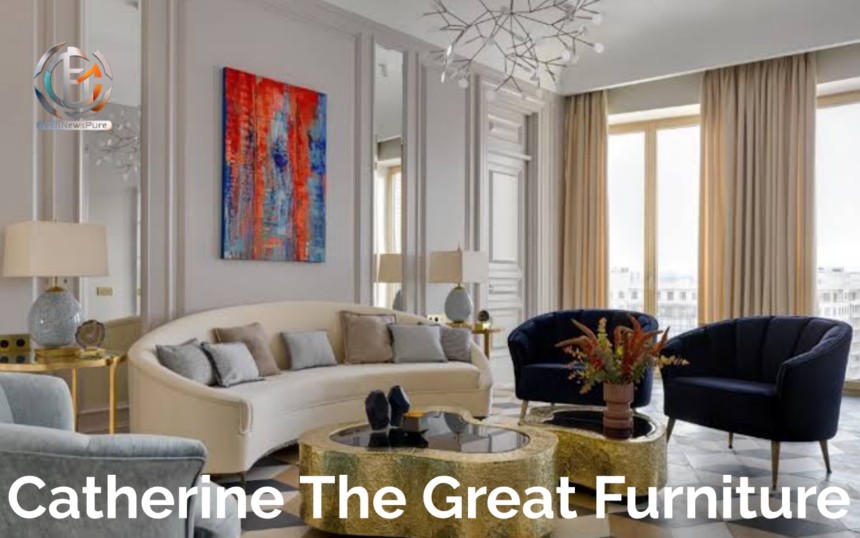Catherine the Great, Empress of Russia from 1762 to 1796, is renowned not only for her political acumen and expansionist policies but also for her patronage of the arts and culture. One of the lesser-known yet significant aspects of her legacy is her influence on furniture design and craftsmanship. The opulence and sophistication of Catherine the Great’s furniture reflect her taste and the era’s artistic trends. This article delves into the history, styles, and significance of Catherine the Great’s furniture, offering a glimpse into the luxurious world of 18th-century Russian royalty.
The Historical Context of Catherine the Great’s Reign
Catherine the Great, born Sophie Friederike Auguste von Anhalt-Zerbst in 1729, ascended to the Russian throne after the deposition of her husband, Peter III. Her reign, marked by substantial territorial expansion and internal reforms, also witnessed a cultural renaissance in Russia. Influenced by Enlightenment ideals, Catherine promoted education, the arts, and architecture. Her passion for Western European culture significantly shaped Russian aesthetics, including furniture design. Under her patronage, Russian artisans and craftsmen flourished, creating pieces that blended Russian traditional elements with European styles.
The Influence of European Styles
Catherine the Great was a great admirer of European art and culture, particularly that of France. This admiration is evident in the furniture styles she favored and commissioned. During her reign, the Rococo and Neoclassical styles were predominant in Europe, and these influences permeated Russian furniture design. The Rococo style, characterized by its ornate and asymmetrical designs, elaborate decorations, and use of light pastel colors, appealed to Catherine’s taste for grandeur and elegance. However, by the latter part of her reign, Neoclassicism, with its emphasis on simplicity, symmetry, and inspiration from classical antiquity, became more prominent.
Catherine’s palaces were filled with furniture that mirrored these styles, often crafted by the finest European and Russian artisans. The blending of these influences resulted in unique pieces that combined European sophistication with Russian grandeur.
The Craftsmanship Behind the Furniture
The furniture from Catherine the Great’s era is a testament to the exceptional craftsmanship of the time. Artisans employed a variety of materials, including exotic woods, gilt bronze, marble, and precious stones. Intricate marquetry, inlay work, and gilding were common features, showcasing the artisans’ skills and the era’s opulence.
One notable craftsman of the time was David Roentgen, a renowned German cabinetmaker whose works were highly prized across Europe. Roentgen’s creations, known for their innovative mechanisms and exquisite detailing, found favor with Catherine the Great. His pieces often incorporated hidden compartments, elaborate marquetry, and mechanical features, adding an element of surprise and functionality to the luxurious designs.
Russian craftsmen also played a crucial role in creating furniture for the empress. The Imperial Cabinet Workshop, established by Peter the Great and expanded under Catherine, produced many of the masterpieces that adorned the royal residences. These artisans drew inspiration from European styles but added a distinct Russian flair, resulting in unique and highly sought-after pieces.
Iconic Pieces from Catherine the Great’s Collection
Several iconic pieces of furniture from Catherine the Great’s collection have survived to this day, providing a glimpse into her exquisite taste and the era’s craftsmanship. One such piece is the grandiose Rococo-style desk created by David Roentgen. This desk, adorned with intricate marquetry depicting scenes from classical mythology, features numerous hidden compartments and mechanical drawers, exemplifying Roentgen’s ingenuity and skill.
Another notable piece is the Catherine II Throne, an opulent Neoclassical masterpiece crafted by the Imperial Cabinet Workshop. This throne, made of gilded wood and upholstered in rich velvet, is adorned with intricate carvings and classical motifs, reflecting Catherine’s admiration for ancient Greek and Roman art.
The empress’s passion for collecting extended beyond furniture to include entire room ensembles. The Amber Room, originally created for Frederick I of Prussia and later presented to Peter the Great, was installed in the Catherine Palace during her reign. This breathtaking room, adorned with amber panels, gold leaf, and mirrors, is considered one of the most magnificent examples of Baroque interior decoration.
Read More: Sheds London Ilikesheds.com | Leading UK Supplier of Garden Sheds 2024
The Legacy of Catherine the Great’s Furniture
Catherine the Great’s influence on furniture design extended beyond her lifetime, shaping Russian aesthetics for generations. Her patronage of the arts and dedication to fostering craftsmanship created a legacy that continued to inspire and influence Russian artisans and designers. The furniture from her era remains a symbol of opulence, elegance, and cultural exchange.
Today, many of these exquisite pieces can be found in museums and private collections around the world. The State Hermitage Museum in St. Petersburg, one of the largest and most prestigious museums globally, houses an extensive collection of furniture from Catherine the Great’s time. Visitors can admire the intricate designs, luxurious materials, and exceptional craftsmanship that characterized the empress’s taste.
Conclusion
Catherine the Great’s furniture is more than just a collection of opulent pieces; it is a testament to her cultural vision and the artistic achievements of her reign. By blending European styles with Russian craftsmanship, Catherine created a unique and enduring legacy in the world of furniture design. Her patronage not only elevated the status of Russian artisans but also left a lasting mark on the artistic heritage of Russia. Today, the furniture from her era continues to captivate and inspire, offering a glimpse into the luxurious world of one of history’s most influential and enigmatic rulers.



